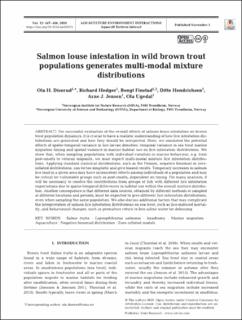| dc.contributor.author | Diserud, Ola Håvard | |
| dc.contributor.author | Hedger, Richard David | |
| dc.contributor.author | Finstad, Bengt | |
| dc.contributor.author | Hendrichsen, Ditte Katrine | |
| dc.contributor.author | Jensen, Arne Johan | |
| dc.contributor.author | Ugedal, Ola | |
| dc.date.accessioned | 2020-11-05T07:45:50Z | |
| dc.date.available | 2020-11-05T07:45:50Z | |
| dc.date.created | 2020-11-04T14:57:20Z | |
| dc.date.issued | 2020 | |
| dc.identifier.citation | Aquaculture Environment Interactions. 2020, 12 447-456. | en_US |
| dc.identifier.issn | 1869-215X | |
| dc.identifier.uri | https://hdl.handle.net/11250/2686479 | |
| dc.description.abstract | For successful evaluation of the overall effects of salmon louse infestation on brown trout population dynamics, it is crucial to have a realistic understanding of how lice infestation distributions are generated and how they should be interpreted. Here, we simulated the potential effects of spatio-temporal variance in lice larvae densities, temporal variance in sea trout marine migration timing and spatial variance in marine habitat use on lice infestation distributions. We show that, when sampling populations with individual variation in marine behaviour, e.g. from post-smolts to veteran migrants, we must expect multi-modal mixture lice infestation distributions. Applying standard statistical distributions, such as the Poisson, negative binomial or zeroinflated distributions, can be too simplistic and give biased results. Temporary increases in salmon lice load in a given area may have inconsistent effects among individuals of a population and may be critical for vulnerable groups such as post-smolts, dependent on timing. For many analyses, it will be necessary to resolve the contributions from groups of fish with different lice infestation expectations due to spatio-temporal differences in habitat use within the overall mixture distribution. Another consequence is that different data sources, obtained by different methods or sampled at different locations and periods, must be expected to give different lice infestation distributions, even when sampling the same population. We also discuss additional factors that may complicate the interpretation of salmon lice infestation distributions on sea trout, such as lice-induced mortality, and behavioural changes, such as premature return to less saline water for delousing. Salmo trutta · Lepeophtheirus salmonis · Anadromy · Marine migration · Aquaculture · Negative binomial distribution · Zero-inflated models | en_US |
| dc.language.iso | eng | en_US |
| dc.publisher | Inter Research | en_US |
| dc.rights | Navngivelse 4.0 Internasjonal | * |
| dc.rights.uri | http://creativecommons.org/licenses/by/4.0/deed.no | * |
| dc.title | Salmon louse infestation in wild brown trout populations generates multi-modal mixture distributions | en_US |
| dc.type | Peer reviewed | en_US |
| dc.type | Journal article | en_US |
| dc.description.version | publishedVersion | en_US |
| dc.subject.nsi | VDP::Zoologiske og botaniske fag: 480 | en_US |
| dc.subject.nsi | VDP::Zoology and botany: 480 | en_US |
| dc.source.pagenumber | 447-456 | en_US |
| dc.source.volume | 12 | en_US |
| dc.source.journal | Aquaculture Environment Interactions | en_US |
| dc.identifier.doi | 10.3354/aei00374 | |
| dc.identifier.cristin | 1844952 | |
| dc.relation.project | Andre: Environment Agency of Norway | en_US |
| dc.relation.project | Andre: Ministry of Trade, Industry and Fisheries | en_US |
| dc.relation.project | Egen institusjon: Norwegian institute for nature research (NINA) | en_US |
| dc.description.localcode | © The authors 2020. Open Access under Creative Commons by Attribution Licence. Use, distribution and reproduction are un - restricted. Authors and original publication must be credited. | en_US |
| cristin.ispublished | true | |
| cristin.fulltext | original | |
| cristin.qualitycode | 1 | |

